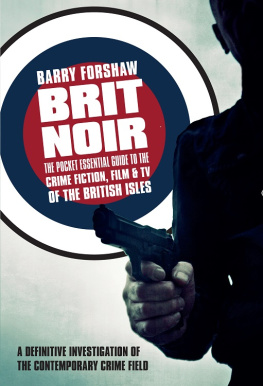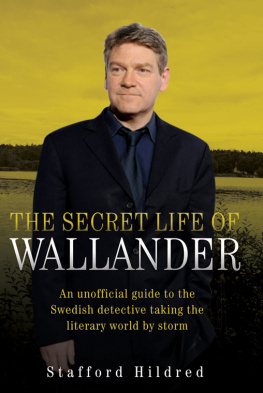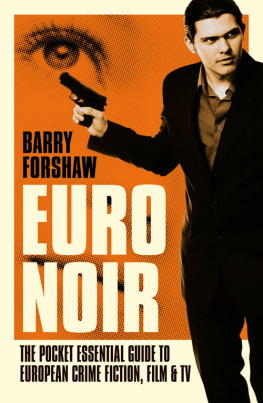Nordic Noir:The Pocket Essential Guide to Scandinavian Crime Fiction, Film and TV by Britains leading expert on crime fiction, Barry Forshaw, is a compact and authoritative guide to the phenomenally popular genre. The information-packed study examines and celebrates books, films and TV adaptations, from Sjwall & Wahls highly influential Martin Beck series through Henning Mankells Wallander (subject of three separate TV series) to Stieg Larssons groundbreaking The Girl with the Dragon Tattoo, cult TV hits such as the Danish The Killing, The Bridge and the political thriller Borgen, up to the massively successful books and films of the current king of the field, Norways Jo Nesbo.
Nordic Noir anatomises the nigh-obsessive appeal of the subject and highlights every key book, film and TV show. For both the beginner and the aficionado, this is a hugely informative, highly accessible guide (and shopping list) for an essential crime genre.

Barry Forshaws latest books are British Crime Film and Death in a Cold Climate: A Guide to Scandinavian Crime Fiction. Other work includes British Crime Writing: An Encyclopedia, The Rough Guide to Crime Fiction and Guns for Hire: The Modern Adventure Thriller, along with books on Italian cinema and the first biography of Stieg Larsson. His next books areBritish Gothic Cinema and a study of Thomas Harris and The Silence of the Lambs. He writes for various newspapers, edits Crime Time, and broadcasts for ITV and BBC TV documentaries. He has been Vice Chair of the Crime Writers Association.

POCKET ESSENTIALS
To all the Scandinavian authors, publishers, translators, screenwriters, directors, producers and other creative personnel who were so generous with their time (and company) when I was writing this study.
Contents
Chapter 1
Chapter 2
Chapter 3
Chapter 4
Chapter 5
Chapter 6
Chapter 7
Chapter 8
Introduction
The Slow Explosion
How does one become an expert in a given subject? Scandinavian crime fiction and films, say. Hard work? Laser-sharp intellect? Knowing the right people? A command of multiple languages? In my case, becoming the UKs leading expert in the field of Nordic crime fiction (I can use that phrase in all modesty, as its not my quote) was, frankly, accidental. Writing about crime novels for a range of newspapers, and producing various books on the subject over the years (as well as editing Crime Time both in its magazine days and in its current online incarnation), it was inevitable that I reviewed as much foreign fiction in translation as I did the British and American varieties. (I always reviewed novels in translation my expertise in foreign languages leaves a lot to be desired. Although, of course, I now speak perfect Danish after watching The Killing.) And I can clearly remember a time when the Swedish authors Henning Mankell and Sjwall & Wahl were not regarded as part of any clearly defined Scandinavian wave. They were simply highly accomplished practitioners of crime fiction, distinguished as much by their markedly left-wing perspective as by the fact that they were from a Nordic country (the former characteristic was by no means de rigueur in the genre at that time). But they coexisted alongside such non-British masters as the Belgian Georges Simenon and the Italian Andrea Camilleri in other words, as very able writers from specific foreign countries, but not necessarily part of a wave. However, we can now see that these writers were laying the groundwork (albeit unconsciously) for an explosion that was about to detonate an explosion called Stieg Larsson. When The Girl with the Dragon Tattoo was published in the UK (its title thankfully rejigged from the uningratiating Men Who Hate Women), we were aware that the author already deceased before we had read a word he had written was something of a phenomenon in his native Sweden.
But who knew we were looking at an all-conquering literary phenomenon?
No Crystal Ball
Id like to say that I saw the current Scandinavian invasion coming, but, to be honest, I cant really claim any such precognitive powers. Along with everything from Chandler to Highsmith, I remember reading the influential novels of Sjwall & Wahl and noting that this Scandinavian duo was clearly indebted to the American 87th Precinct books by Ed McBain, and I also noted the remarkable pared-down, no-nonsense efficiency of the prose. What I confess I didnt notice was the Marxist perspective (more on that later), but the books ended up being salted away on my shelves alongside contemporaneous crime fiction from Britain and America and other points of the compass. The other major indicator that a Nordic literary invasion was on the horizon was, of course, the impact of Swedish writer Henning Mankell. (He was also influenced by Sjwall & Wahl, as he told me when speaking to other Scandinavian writers, I was to discover that virtually everyone in the Nordic Noir sphere was inspired by the duo.) Mankells memorable Wallander novels, with their saturnine detective, quickly began to make a mark on the crime fiction scene even becoming emblematic of the whole field. Scandinavian crime? Think Wallander.
The Late Mr Larsson
And sometime later, when The Times commissioned me to write a piece about the late Stieg Larsson (who was just beginning to create the seismic rumble that developed into the volcanic sales he subsequently enjoyed), it was clear that a distinctive genre with its own parameters now visible had arrived. However, this remained a literary phenomenon, and in the various pieces I was asked to pen I examined it simply in those terms. But then the second wave appeared, courtesy of film and television: the Swedish film of The Girl with the Dragon Tattoo and on television the amazing success of the Danish series The Killing. The latter went from cult phenomenon to minor British obsession (not least for its unsmiling heroine Sarah Lund, played by Sofie Grbl). And when in 2012 I found myself interviewing the modest writer of the series, Sren Sveistrup, in front of an audience enthralled by this talented (but hitherto unseen) creator, it seemed that the Scandinavian invasion was complete.
Happiness is a Thing Called Jo
Ian Rankin said in the Daily Record in 2012: Scandinavian crime writers are not better than Scottish ones, they just have better PR. If hes right, Jo Nesbo has the best in the business. Perhaps the most forceful indicator of the current domination of the crime fiction scene by Scandinavians is the astonishing success of the Norwegian writer (and ex-footballer and ex-rock star) Jo Nesbo. An indication of that success is the fact that the films of his work routinely precede the title with his name (e.g. Jo Nesbos Headhunters). Until recently, the strapline on his paperbacks was The Next Stieg Larsson, a soubriquet which (I have to admit) was mine except that it wasnt quite. I was trying to convey to newspaper readers that, if they had avidly consumed everything by Larsson, Mankell and co., they should try the remarkably talented Nesbo. But I cant really complain that my quote was tweaked slightly. Nesbo has since told me that, although his books are nothing like those of his late Swedish confrre, he didnt mind the quote success is success. But even Jo Nesbos celebrity represents only a fraction of the Nordic phenomenon and the concomitant amount of remarkable Scandinavian crime writing now available in translation for English-speaking readers.
Next page











